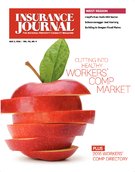If insurance is the best kept secret in the business world, then the E&S sector is the best kept secret in the insurance industry.
That’s according to Hank Watkins, president of Lloyd’s America, who talked fondly in mid-April about excess and surplus lines before a large gathering of business students and insurance executives in Southern California.
Watkins was the guest speaker at E&S Day at Cal State University Fullerton’s Center for Insurance Studies, which is part of the Mihalylo College of Business and Economics.
The Lloyd’s chief explained the industry and gave an E&S review and outlook for the benefit of students taking insurance-related courses at the school, which often hosts notable insurance executives for discussions and seminars.
Watkins explained how the E&S business insures risks that other insurers won’t, and then when the E&S sector proves those risks are insurable, or are a good business to be in, the rest of the industry moves in to offer products for those risks.
“There’s enough challenging things that come around in our world that gives the E&S sector plenty to do,” Watkins added.
He also called E&S a “surge tank” for the insurance industry, a role it plays when insurers pull out of a particular risky market and the E&S sector moves in.
Autonomous vehicles, drones and ridesharing were among examples Watkins offered of emerging risks that the E&S sector took on first.
The satellite industry is another business, one which Lloyd’s doesn’t shy away from, that Watkins talked about.
“Every once in a while a satellite goes straight up and back down, and that’s $350 million – $400 million,” he said. “That’s a bad day.”
Property insurance, where E&S is a big player in coastal communities like those in Florida and those along the Eastern Seaboard, can also be risky, he said. An example he used was the hit Lloyd’s took from Superstorm Sandy in 2012.
“Lloyd’s alone had about $2.5 billion of that $25 billion loss,” he said.
Of course, since Lloyd’s is noted for insuring stars, taste buds and athletes, Watkins also drew the students’ attention to some of the more interesting policies written, such as the a million-dollar-plus policy for recently retired Pittsburgh Steeler defender Troy Polamalu’s hair all the way back to Betty Grable’s legs.
Watkins described E&S as a sector that will take on most risks, including modern and still little understood risks like cyber.
However, he said he’s still unsure whether current modeling is adequate to accurately assess cyber risks, because the economic harm of such attacks may be vast and far-reaching.
“I’m not convinced we’re there yet,” he said. “We have no idea what the downside is of cyber-attacks.”
The underlying point of Watkins’ visit was of a recruiting nature, giving students an idea of the opportunities the business offers.
He fielded a number of questions from students, which ranged from insuring wearable technology to drones to cyber risk. He relayed a personal parable after he was asked where he started.
He began as an underwriting trainee at Chubb, but it was a long road just to get to that point.
He submitted his resume for an opening, was rejected, then called to find out why he was rejected, but his call was not returned. More calls were made, and more calls went unreturned.
So Watkins, then 21, donned a suit and went to the office, where his persistent nature was met with a welcome reception.
“I was interviewed by just about everyone there,” he said.
After his personal story, answering questions, and explaining more about how E&S and the industry in general works, Watkins went back to his pitch.
“It’s a really cool industry,” he said. “We’re very engaged with our communities.”
E&S Day continued after Watkins’ talk. A panel and a round table discussion followed.
Hank Haldeman, executive vice president and director with The Sullivan Group and president of the National Association of Professional Surplus Lines, moderated the panel.
The panelists were Timothy Chaix, president of R.E. Chaix & Associates; Lori Hunter, executive vice president and Worldwide Facilities Inc.; Steve Cius, area president of Risk Placement Services Inc.; and Anthony Manzitto, chief operating officer and executive vice president of Topa Insurance Group.
The panelists took over where Watkins left off and further explained the E&S industry, how it works, and why it is exciting – and sometimes risky
Manzitto used as an example the mess in the Porter Ranch community of Los Angeles County, where the impacts are still being felt from the country’s largest ever accidental release of methane, which occurred over several months and sickened and displaced thousands of households.
“That’s a gigantic loss where there is a going to be a number of E&S carriers involved,” Manzitto said.
Was this article valuable?
Here are more articles you may enjoy.



 Allstate Reports $731M in Q1 Pretax Catastrophe Losses
Allstate Reports $731M in Q1 Pretax Catastrophe Losses  JPMorgan Client Who Lost $50 Million Fortune Faces Court Setback
JPMorgan Client Who Lost $50 Million Fortune Faces Court Setback  USAA to Lay Off 220 Employees
USAA to Lay Off 220 Employees  Uncertainty Keeps Prices Up; No Prior-Year Loss Development: Travelers
Uncertainty Keeps Prices Up; No Prior-Year Loss Development: Travelers 


